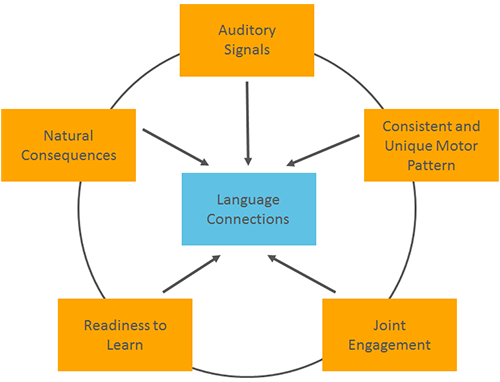Components of LAMP™
Readiness to Learn
In order to learn, an individual must be in an arousal state compatible for attending and learning. For individuals with developmental disabilities, particularly those with autism spectrum disorders, achieving and maintaining this state of readiness to learn can be challenging.
Sensory techniques to help that individual maintain an optimal level of arousal need to be incorporated into treatment sessions. Not only do sensory motor activities help to modulate an individual’s level of arousal, but they tend to be inherently motivating and enjoyable for the child.
To keep the individual’s interest, it is necessary to follow their lead in determining the vocabulary to be introduced to match their desire to communicate. Natural, intrinsically motivating activities tend to encourage interactive communication and engagement, while maintaining interest more so than activities that are rote, drill and compliance-based.
Joint Engagement
When introducing an AAC device, the communication partner should follow the child’s lead and introduce and expand vocabulary around the child’s interests.
Spontaneous, child-led intervention encourages the child to communicate naturally and keeps him engaged longer. Vocabulary is generalized more readily when learned in natural activities than when taught in structured, compliance-based activities. Communication should be rewarding and not feel like work. As the non-verbal individual begins to understand the power of communication, you will typically see increased joint attention and engagement.
Consistent and Unique Motor Patterns
The primary principle of the LAMP approach is that the motor plan a person uses to utter a word cannot be changed once it is learned. In order to communicate effectively, a person has to be able to monitor his environment, listen to another speaker and follow the flow of the conversation. This cannot happen effectively if he has to cognitively attend to the icons, categories and locations of vocabulary on his device.
Our brain develops motor plans to control movements that are used over and over again so that they may occur automatically without much thought. Examples of everyday activities for which we use motor plans include:
- Typing
- Handwriting
- Tying shoes
- Certain aspects of driving a car
 When verbal individuals talk, they don’t have to concentrate on how to make the sounds that make up words; they concentrate on the idea of what they want to convey. The same principle holds true with an augmentative communication device as it replaces our articulators. If the motor movement required to say a word changes from one activity to another or over the course of an individual’s life as his need for vocabulary grows, the cognitive load for communication is increased.
When verbal individuals talk, they don’t have to concentrate on how to make the sounds that make up words; they concentrate on the idea of what they want to convey. The same principle holds true with an augmentative communication device as it replaces our articulators. If the motor movement required to say a word changes from one activity to another or over the course of an individual’s life as his need for vocabulary grows, the cognitive load for communication is increased.
Auditory Signals
The additional sensory input of the voice on a speech generating devices is significant for a number of reasons. The more sensory feedback available when learning a task, the easier it is to learn. Additionally, the pairing of auditory feedback with a consistent and unique motor movement may play a role in audtiory processing, segmentation fo speech and language development.
Even when there is not a communication partner, language learning can occur as the word matching a particular motor movements is heard allowing the individual to learn language through babbling.
Natural Consequences
Particular motor movements are repeated and learned based on the feedback received. Providing a intrensically rewarding natural consequence attributes meaning to the word spoken. To teach language, the communcative partner should provide:
- An animated reaction to the utterance;
- The requested activity/or item; or
- An appropriate response to enhance the meaning of the uttered word.
Resonses that are playful, fun, or involve the intersts of the nonspeaking individual will keep them engaged. When the interaction is joyful, memory is enhanced. A visual/sensory response is particularly helful for the individual with auditory processing issues.
